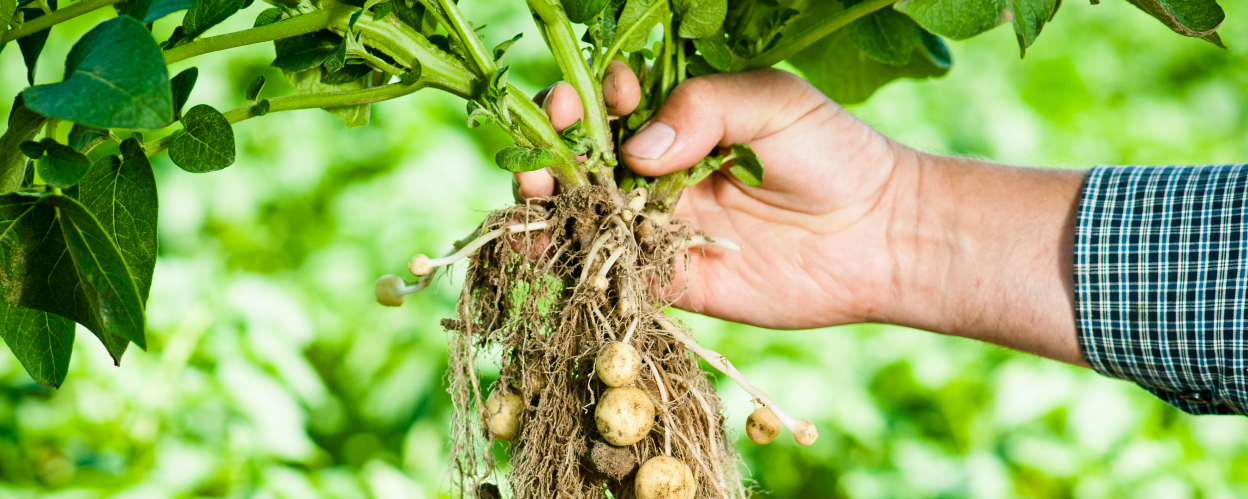
The ideal potassium fertilizer for potatoes
Of all plant nutrients, potassium is the one that has the strongest influence on the internal and external quality of the potato. First of all, it is important that potassium is made available to the potato plants in sufficient quantities. In potato cultivation, moreover, the nutrient form with which potassium is applied deserves special attention. This is because potassium is available in sulfate or chloride form for basic fertilization. Potassium chloride is present in liquid manure, for example. Mineral fertilizers are available in both sulfate and chloride form. The plant nutrient has a significant influence on quality parameters, such as starch content in tubers and the reduction of black spot. Furthermore, potassium contributes to a strong taste of the potato and helps the product to prevent cooking darkening.
The potato is sensitive to chloride
Starch and processing potatoes are considered chloride sensitive, while seed and table potatoes are considered chloride tolerant to a limited extent. For table potatoes, potassium fertilization can be partially applied in chloride form as long as it is done well in advance of the start of vegetation - the ideal time is in the fall of the previous year.
The aim of this form of fertilization is to ensure that a large proportion of the chloride from the potassium fertilizer is displaced or leached into deeper soil layers. In the process, however, the farmer runs the risk - especially on lighter soils - that high precipitation will lead to leaching losses of potassium. On heavier soils, in turn, the chloride may return to the root zone of the potatoes with the help of capillary water flow during the summer months, and unexpected salt stress may have a negative impact.
Potassium sulfate promotes starch content

It has long been known that the use of potassium chloride reduces the starch content of potatoes compared to potassium sulfate. This can be clearly observed in the graph on the right. The reason for this is the chloride ions, which hinder the transportation of carbohydrates of photosynthesis from the leaves into the tuber. This results in a buildup of starch in the leaves, while too little starch is stored in the tubers. Chloride furthermore causes higher internal cell pressure and a lower dry matter content of the tubers.
Please note the following with regard to chloride fertilization: When growing table potatoes in particular, their typical starch content is often exceeded in good to very good soils (loess loam soils), as a result of which these varieties may lose their firm cooking properties. In these cases, chloride-based potassium fertilization certainly helps to achieve a desirable reduction in starch content. Due to the risk of yield losses, this procedure should only be used if excessive starch content is expected for good to very good soils.
Potassium sulfate creates a better taste

On light soils typical for potato cultivation, the problem of excessive starch content in food varieties rarely occurs. Here, the choice of a chloride potassium fertilizer quickly leads to a reduction of the starch content far below the variety-specific value. The quality of table potatoes suffers considerably as a result, since the tubers become more watery on the inside and less storable. Since starch is also an important flavor carrier, under these conditions the potato lacks the flavor of a good table potato expected by the consumer.
Sulfate potassium fertilization, on the other hand, results in a higher dry matter content in the tuber, which, in combination with a favorable starch : protein ratio (12-16 : 1), is reflected in a savory, strong flavor. Direct marketers in particular must not neglect this quality feature.
Potassium sulfate with magnesium is effective against black spot

The marketability of table potatoes can be significantly impaired by black spot. Many different factors influence the tendency for such discoloration to occur. Their occurrence can be counteracted by plant cultivation measures. For example, variety, skin firmness, harvesting and post-harvest conditions and conditions during storage (mechanical stress) have a direct effect on potato black spot.
Fertilization can also reduce, even if only indirectly, crop black spot. This is because, as shown in the adjacent graph, potassium fertilization leads to a significant reduction in black spot.
Micronutrients reduce black spot
In addition to magnesium, the micronutrient boron is an important building block for the structure of cell walls and therefore contributes to the reduction of pressure sensitivity and susceptibility to black spotting. On the basis of a series of experiments concerning leaf fertilization, it could be shown that a double leaf application of magnesium sulfate (epsoTOP) reduces the proportion of tubers with black spotting. The proportion of tubers with black spotting decreased even more after the application of magnesium sulfate with the micronutrients boron and manganese (epsoMICROTOP).
Potassium influences citric acid content and cooking blackening

In contrast to black spots, cooking darkening is caused by the reaction of phenols (e.g. chlorogenic acid) with free metals, for example iron. Due to a complex formation between the free metals and citric acid, iron is bound and can no longer react with the phenols. The tendency to cooking darkening is therefore reduced. The content of citric acid can be influenced by fertilization. As shown in the illustration, the citric acid content of the potato increases with increasing potassium supply. The highest citric acid content is achieved when the tuber contains 2.5 percent potassium.
Consider the right form of nutrients when fertilizing potatoes
The potato is one of the most versatile but also one of the most demanding crops there is. Therefore, it is all the more important for you as a farmer to know your exact cultivation goals, i.e. the desired characteristics and qualities you want to achieve. Otherwise, the potato harvest may suffer qualitative and quantitative losses, e.g. due to black spots, inappropriate starch content, darkening during the cooking process, etc. In order to meet all quality requirements, an optimal nutrient supply is required, both in terms of the quantity of nutrients applied and the selected nutrient form: sulphate vs. chloride.
Apart from yield and quality, an important reason for fertilization is the sustainable maintenance of soil fertility. This is essential for the long-term securing of natural yield potential. For this purpose, it is necessary to maintain an optimal level of soil nutrient content (in Germany, soil content class “C”). Which in turn means that nutrients that have been removed with the crop must be replaced by fertilizer application. In addition to nutrient removal, allowances for site-specific losses (e.g. due to leaching) should be considered as well as compensation for previous deficits where appropriate. The total deprivation of plant stock results from the removal of nutrients by draining the main harvest product, the tuber and harvest residue cabbage. If the harvest residues remain on the land, only the nutrient removal resulting from the main harvest product needs to be replaced.
Play it safe with potassium sulfate
The ideal nutrient form in potatoes depends on the direction of utilization. In certain cases, chloride fertilization is possible, but carries the risk of yield losses, as potatoes are sensitive to chloride. Play it safe with a sulfate-based potassium fertilization. Potassium sulfate promotes starch content and flavor and reduces black spotting.




